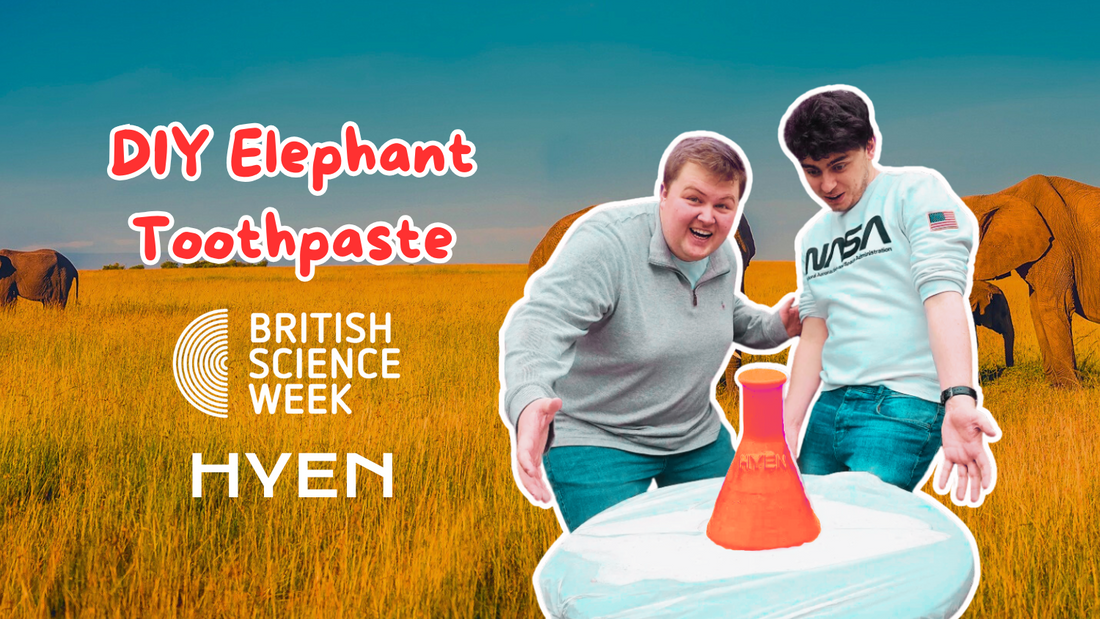
How to Make Elephant Toothpaste - Easy & Fun DIY Science Experiment
Share
Celebrating British Science Week with a Fun Experiment!
British Science Week is here, and what better way to celebrate than with an exciting hands-on experiment? Elephant toothpaste is a fantastic activity that creates an exciting foamy eruption while teaching kids about chemical reactions! Perfect for parents, teachers, and youth groups, this experiment is safe, engaging, and packed with STEM learning opportunities.
What is Elephant Toothpaste?
Despite its name, elephant toothpaste isn't really for elephants! It's a foamy explosion caused by the fast breakdown of hydrogen peroxide. This releases oxygen bubbles in a fun and dramatic way. Kids will love watching the giant foam tower grow, and will learn some cool science in the process.

Ingredients and Materials
Here's what you'll need to make your own elephant toothpaste at home or in a classroom:
Ingredients:
- 240ml of Hydrogen Peroxide (3%-6%, higher works best!)
- 1-2 sachets of fast acting dry yeast
- 240ml of warm water
- A few drops of dish soap
- Optional: Food colouring (makes it extra fun!)
Equipment:
- A plastic bottle (750ml soda bottle or similar works well) or Erlenmeyer flask
- A tray or large dish (to catch the messy foam)
- A small cup for mixing yeast and water
- Safety glasses and gloves (recommended, especially with stronger hydrogen peroxicde)
Safety Tips
⚠️ Hydrogen peroxide can be irritating, so adults should only handle it and use gloves with safety glasses if using stronger concentrations (6% or higher).
⚠️ Do not eat or drink any of the materials used in the experiment.
⚠️ Clean up by rinsing the foam down the sink with plenty of water.
Instructions
1. Prepare Your Bottle
Place your bottle/flask on a tray to catch the overflowing foam. Add 240ml hydrogen peroxide into the bottle/flask.

2. Add Dish Soap & Colour
Add a few drops of dish soap to help trap the bubbles, making the foam extra thick. If you want colourful foam, mix in a few drops of food colouring.
3. Activate the Yeast
In a separate cup, mix the yeast with the warm water. Stir for about 30 seconds and wait 2-3 minutes to activate the yeast.

4. Start the Reaction!
Quickly pour the yeast mixture into the bottle, then step back and watch the magic happen! The reaction will create a giant foamy eruption!

The Science Behind the Foam
This experiment demonstrates a chemical reaction called catalytic decomposition. Here’s what happens:
👉 Hydrogen Peroxide (H₂O₂) naturally breaks down into water (H₂O) and oxygen (O₂) over time. However, the yeast contains an enzyme called catalase, which speeds up this breakdown.
👉 The oxygen gas gets trapped in the dish soap, forming thousands of tiny bubbles that create the thick foam.
👉 The reaction releases a small amount of heat, making it an exothermic reaction! (Feel the bottle - it's warm!)
Fun Variations to Try
- Make Rainbow Foam: Use multiple bottles with different food colours for a colourful eruption!
- Time the Reaction: Measure how long the foam keeps expanding. Does more yeast make a difference?
Why This Experiment is Great for Learning
This activity is perfect for introducing kids to chemistry, reactions, and scientific curiosity. It encourages observation and hands-on learning. Plus, it’s just so much fun!
As part of British Science Week, we’re sharing a special video of this experiment on our Instagram and TikTok! So whether you're a parent, teacher, or youth leader, give this a try and spark excitement for science!
Tag us on social media if you try this experiment – we’d love to see your foamy explosions! #HYEN #STEMfun
Want More STEM Fun? Join the HYEN Club!
Love hands-on science and engineering? Join the HYEN Club for exclusive STEM activities, early product releases, and special discounts! Sign up today and stay inspired with fun experiments and educational resources.
